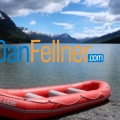A Hassle-Free and Luxurious Way to See Several Fascinating Countries
July/August 2001 — Highroads Magazine
We were a week into our 10-day Baltic cruise, and the cruise director was urging the ship’s weary passengers to resist the temptation to sleep in the following morning so we would have plenty of time to explore the next port-of-call. “You’re not here to have fun,” he said. “You’re here to see the sights.”
His comments were made in jest, of course, but there was more than a shred of truth behind them. Cruising the Baltic Sea in northern Europe is a relatively hassle-free and luxurious way to see several fascinating countries — each with its own unique culture, history and language — in a short period of time.
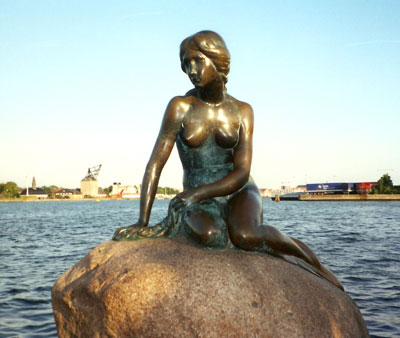
Copenhagen’s Little Mermaid statue.
But don’t plan on getting much rest. Most Baltic cruises offer few days at sea for relaxation and the ports are far too interesting to pass up for a few extra hours of sleep.
Indeed, the Baltic Sea is one of the fastest-growing segments of the cruise industry. Nearly all of the major lines offer summer sailings that visit Scandinavia, Russia, the Baltic Republics and other northern European countries.
We were aboard the Crown Princess, a 1600-passenger ship that began and ended its voyage in Copenhagen, Denmark. In between, we visited Stockholm, Sweden; Helsinki, Finland; St. Petersburg, Russia; Tallinn, Estonia; Gdansk, Poland; and Oslo, Norway.
John Lawrence, our English cruise director, has sailed all over the world in the past 23 years, and calls the Baltic one of his three favorite itineraries (the other two being China and Australia/New Zealand). “It appeals to my sense of what cruising should be all about,” he said. “I look for education, substance and a sense of history — which these ports all offer.”
This isn’t a cruise for party animals. There were no pool games, wild karaoke parties, or limbo dancing. There wasn’t even a midnight buffet. Most of the ship’s passengers were sound asleep by then, resting up from a busy day of sightseeing and readying themselves for the next.
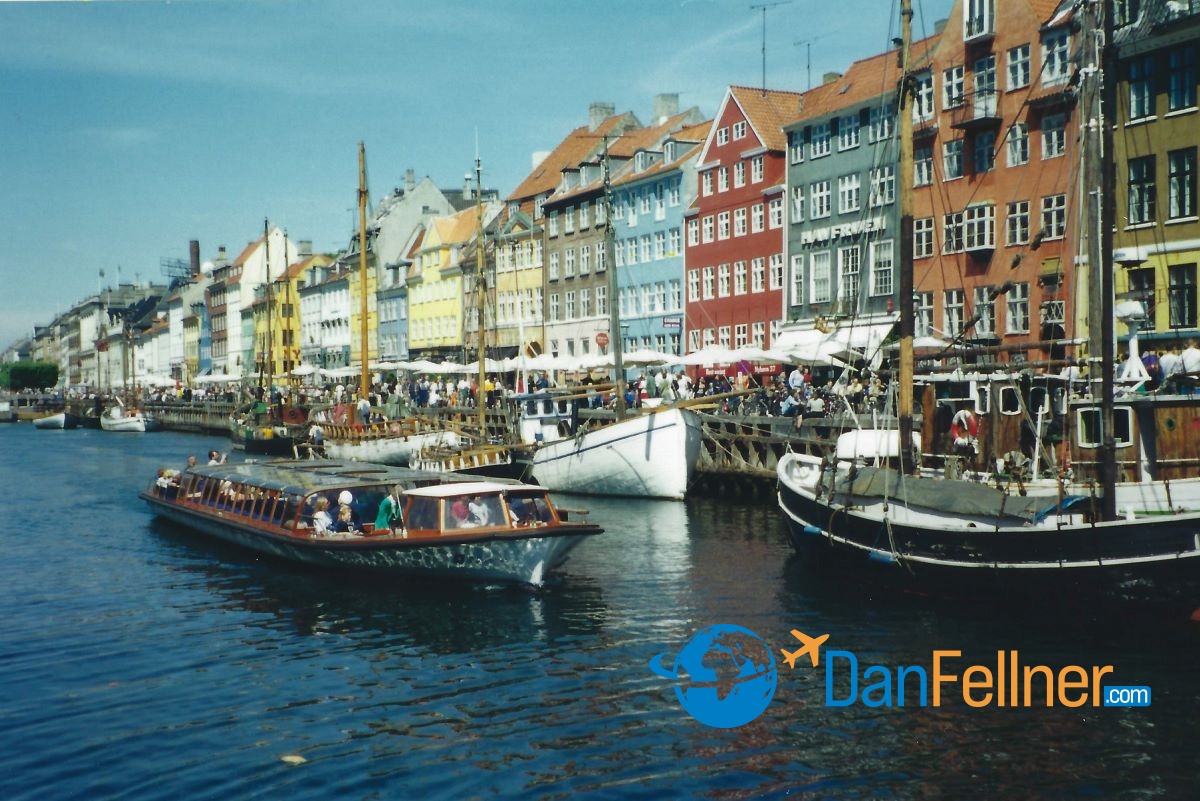
Copenhagen’s colorful Nyhavn district.
One of the most popular shipboard activities was Lawrence’s daily lectures on upcoming ports-of-call. He is an expert on history, having written a book on St. Petersburg and the final days of the Romanovs. His information on the historical significance of what we would be seeing was consumed by the ship’s relatively cerebral passengers with as much fervor as anything served in the dining rooms.
Aside from the sightseeing, history and diversity in the ports-of-call, a Baltic cruise offers tremendous value. Scandinavia is one of the most expensive places in the world. But cruise passengers are mostly immune from this, as their food, lodging and entertainment are provided by the ship. You’ll want to do some shopping, of course, and bargains can be found in Russia, Poland and the Baltic Republics.
After arriving in Copenhagen, a 20-minute cab ride brought my wife and me to the Crown Princess, which was christened in 1990 by Sophia Loren and recently spiffed up with a multi-million-dollar renovation. We had several hours before the ship’s departure, so we began walking and were amazed at how much of Copenhagen we were able to see by foot.
Just 15 minutes from the ship we came across one of the city’s most famous sites — the Little Mermaid statue, inspired by the Hans Christian Andersen fairy tale. Another 10 minutes and we’re at the Amalienborg Palace, winter residence for the Danish Royal Family. Get there at noon to see the changing of the guard. A few blocks away we came across the much-photographed Nyhavn district, a colorful waterfront lined with shops. Copenhagen seems to be a bit more vibrant and a bit less staid than the other Scandinavian capitals.
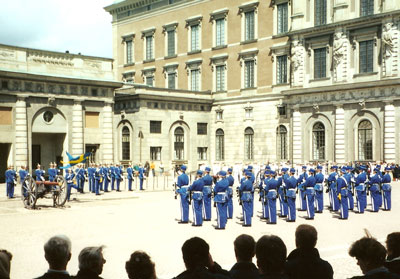
Changing of the guard at Stockholm’s Royal Palace.
Stockholm was the first stop on our ship’s itinerary and we docked in a town called Nynashamn, about an hour outside the city. The ship offered a bus trip into Stockholm for $57. We opted to take public transportation instead — a combination of bus and train — at a cost of only $10. It was safe and easy, and unexpectedly gave us one of our most enjoyable experiences on the trip.
On three separate occasions, locals approached us, sensing we were tourists, to see if we needed assistance. Not only did they give us directions, they actually escorted us to make sure we ended up in the right place. One Swedish businessman even spent two hours walking around with us to make sure we didn’t miss his favorite Stockholm sites.
Stockholm’s can’t-miss site is the Vasa Museum, the home of the world’s oldest fully-preserved ship. The Vasa was launched in 1628 but sank on her maiden voyage. It was discovered and salvaged 40 years ago. It is now the centerpiece of a museum that contains thousands of historic items recovered from the harbor. It’s also worthwhile to take a stroll through the cobblestone streets of Gamla Stan, the city’s old town. Nearby, you’ll find the Royal Palace — changing of the guard is at 1 p.m. — and City Hall, where the Nobel Prizes are awarded.
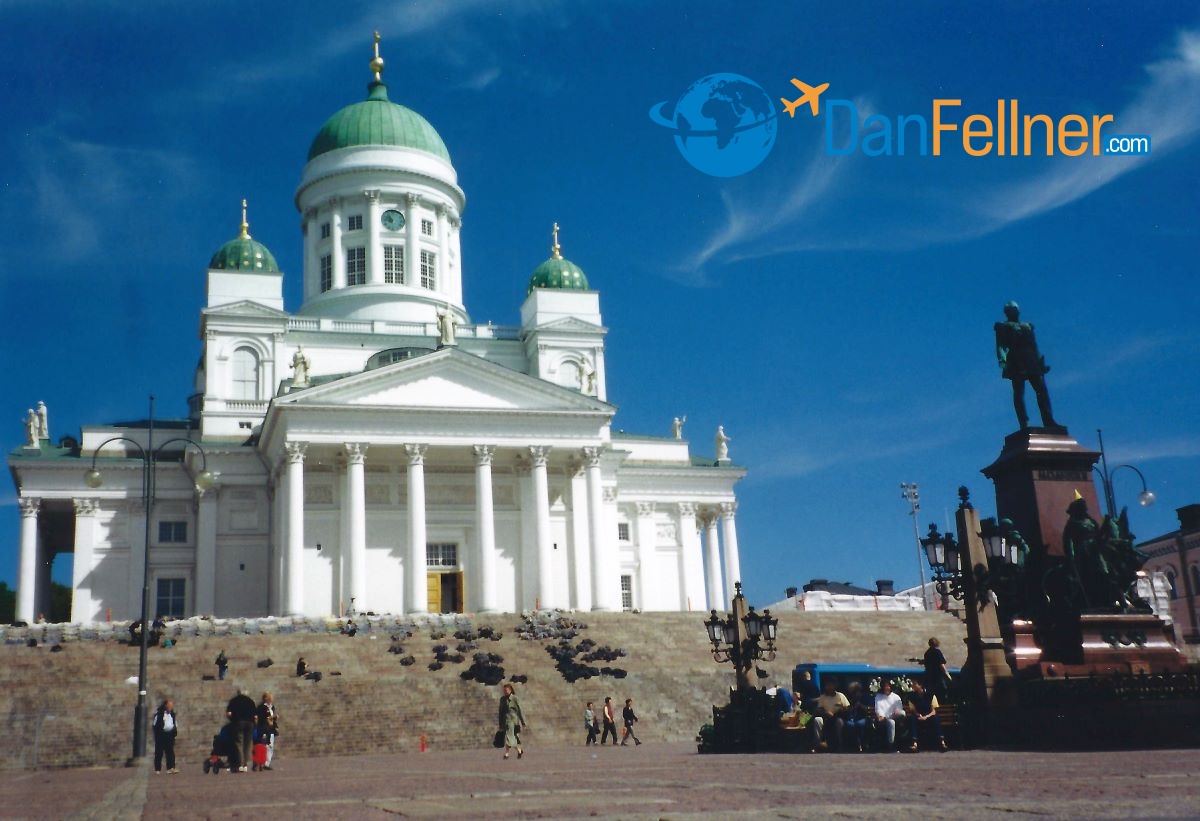
Senate Square in Helsinki, Finland.
Helsinki, one of the cleanest cities on Earth, has a strong Russian flavor. We found the Finns more reserved than the Swedes, but they do love to talk amongst themselves on the phone. In fact, Finland has more cell phones per capita than any other country. To watch the locals shop, head to the colorful Market Square, on the pier not far from where the cruise ships dock. Fishermen sell their day’s catch right off the boat. The city’s focal point, Senate Square, is just a few blocks away. Also worth seeing is a monument to Finnish composer Jean Sibelius, an interesting conglomeration of steel pipes.
The most anticipated port-of-call on the trip was St. Petersburg (formerly called Leningrad), where many cruise ships dock for two full days. Americans need a visa to visit Russia, which costs more than $100 and can be a hassle to get. But the visa requirement is waived if you book tours through the ship. That means, though, you can’t explore the city on your own. Given the warnings we heard about crime in Russia, most passengers didn’t seem to mind being escorted by a guide.
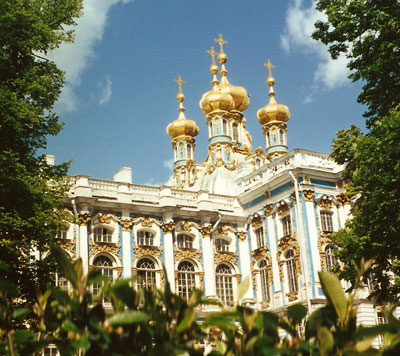
Catherine Palace near St. Petersburg, Russia.
With a population of five million people, St. Petersburg is the country’s second-largest city. It looks a bit dilapidated in places but boasts some wondrous sites. At the top of the list is the Hermitage Museum, which houses one of the largest art collections in the world. In fact, if you spend just 30 seconds looking over each piece of art in the museum, you’ll be there three full years. We had three hours, but got to see plenty of the Czar’s private art collection along with a nice assortment of masterpieces by Rembrandt, Da Vinci and Raphael.
Outside the city are two opulent palaces well worth visiting – the Catherine Palace with a beautiful ornate blue façade, and the Peterhof Palace and Gardens, which was built by Peter the Great to vial the palace at Versailles. In town, you can take in a ballet performance at the Alexandrinsky Theater or sign up for a shopping tour and bargain with vendors for some famous Russian nesting dolls and hand-painted lacquer boxes. One of the best places to find souvenirs is a market located outside the uniquely named Church of the Savior on the Spilled Blood, which is the site of Alexander II’s assassination.

The Town Hall Square in Tallinn, Estonia.
Estonia, which became independent from Russia in 1991, was perhaps the most quaint and charming stop on our cruise. Tallinn is a wonderfully preserved medieval city that can easily be explored on foot.
Start with the Town Hall Square, which has been the heart of the city since the 12th century. It is lined with shops, restaurants and the gothic Town Hall, built in 1371. A few blocks away is Toompea Hill, site of a unique-looking pink building that houses the Estonian Parliament.
The port of Gdynia, Poland is a 45-minute bus trip from historic Gdansk, where the first shots of World War II were fired. Unfortunately, Danzig, as it was known then, was almost completely destroyed during the war, but has since been rebuilt to resemble its medieval past. It’s not as authentic as Tallinn and sort of feels like walking around the Epcot Center. The city’s Old Town features buildings designed in gothic, renaissance and baroque styles.
Our last stop was Oslo, Norway, the oldest, geographically largest and least populated of the Scandinavian capitals, with about half a million residents. Most tours take you to the famous ski jump at Holmenkollen, which offers spectacular views of the city. The Vigeland Sculpture park, set in a scenic park, features the unique and much-admired works of Gustav Vigeland. The Viking Ship Museum houses three well-preserved Viking boats that are more than 1000 years old. On the way back to Copenhagen, we had our best scenery of the trip, sailing through a 60-mile fjord.
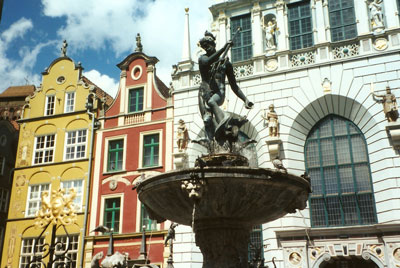
The rebuilt Old Town in Gdansk, Poland.
Our cruise cost just $1,100 per person, including taxes and port charges but not including airfare to Copenhagen. To make it even better, we received a free upgrade to an outside cabin. Overcapacity in the cruise industry continues to make it a buyer’s market. Don’t cruise the Baltic in hopes of getting a suntan. Temperatures during our mid-June trip never rose higher than 65 degrees. Some days were windy, rainy and cold.
And don’t plan on coming home rested and relaxed. In addition to the grueling country-after-country itinerary, jet lag is tougher than normal to deal with because you constantly have to adjust your watch — either forward or backward – throughout the course of the cruise. By the time we got home, we felt like we needed a vacation from our vacation.
But we did return with a suitcase full of enriching memories, and a strong desire to go back and spend more time in some of the countries in which our visit was far too short. Just at a bit slower pace.
© 2009 Dan Fellner



